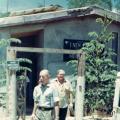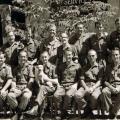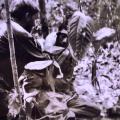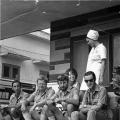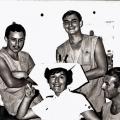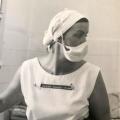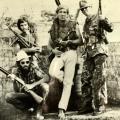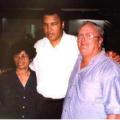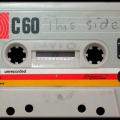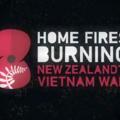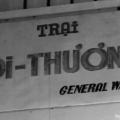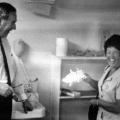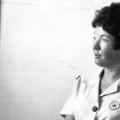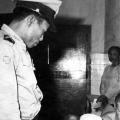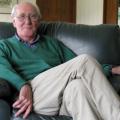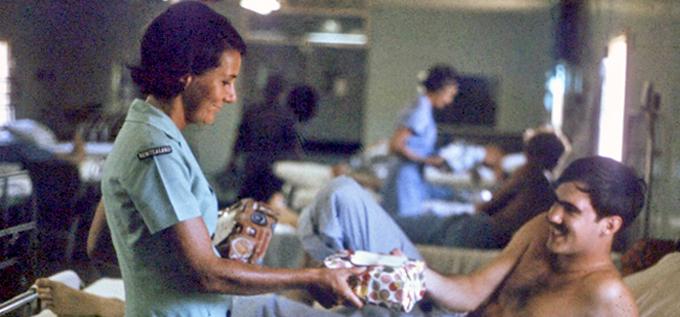
New Zealand Red Cross worker Isabel Beaumont distributes gifts to a soldier at British Military Hospital Changi in Singapore (New Zealand Red Cross)
Initial assistance to Vietnam was a civilian surgical team based at the Binh Dinh Provincial Hospital, Qui Nhon. Part of New Zealand’s aid programme – and our hesitant support for the war – the first team deployed in 1963, two years before New Zealand’s combat commitment – and was the last agency to withdraw in 1975. From 1967, the 1st New Zealand Services Medical Team was based 100 kilometres away at Bong Son, treating civilian casualties of war and accident cases, and training Vietnamese nursing staff. The team was withdrawn in 1971, and its hospital destroyed soon after by North Vietnamese forces during reunification. Nine New Zealand Army nurses in all served at the 1st Australian Field Hospital, Vung Tau. They treated soldiers with illnesses related to the climate and conditions, and were on standby for helicopters bearing soldiers wounded in firefights. New Zealand infantry companies also had army medics, who provided preventative healthcare to soldiers around base – inoculations and treatment for minor ailments – and accompanied troops on operations to care for those wounded in action and awaiting medical evacuation. Two New Zealand Red Cross field workers were also based at Vung Tau.
Civilian surgical team
A six-strong civilian medical team arrived in April 1963 as part of New Zealand’s initial assistance programme to Vietnam under the Colombo Scheme. Based at the Binh Dinh Provincial Hospital, the team treated civilian war and accident casualties from the surrounding area, and trained Vietnamese medics and nurses in modern hospital medicine, and later in maternity, paediatrics, and public health promotion. Dunedin physician Dr Michael Shackleton – accompanied by his wife and five children – was first team leader on the scene in Qui Nhon, and had the difficult task of establishing a base for his crew in the face of staunch resistance from Vietnamese counterparts, inadequate facilities, and little practical support from New Zealand bureaucrats. In 1966, the team grew to 14 – comprising three surgeons, a physician, an anaesthetist, an administrator, a laboratory technician, six nurses, and a maintenance officer. The team was evacuated in March 1975, just before the fall of South Vietnam. However, its work continues today under the auspices of the New Zealand Viet Nam Health Trust (NZVHT), an enduring restorative contribution to war-torn Vietnam. In 1991, a coalition of 12 agencies including Volunteer Services Abroad (VSA), the Red Cross, and NZVHT revived key relationships forged by New Zealand medics and public health practitioners between 1962 and 1975. This collaboration continued until the government withdrew aid funding in 2002.
Services medical team
In early 1967, New Zealand’s medical efforts in Binh Dinh province were bolstered by the formation of a 16-man military medical team. The first joint unit ever created by our armed forces, 1st New Zealand Services Medical Team (1NZSMT) was a tri-services unit made up of army, navy, and air force personnel. Ostensibly controlled by NZ V Force, the team was directed day-to-day by USAID. [1] Led by Second World War veteran Albert Green, the team comprised six army, five air force, and five navy personnel. All regulars, within the team these men served as medical officers (3), medics (12), and an administration officer. The team inherited the work started by an American Military Public Health Assistance Programme (MILPHAP). Initially spread between Bong Son and dispensaries in nearby villages, safety concerns and staffing problems forced the team to consolidate its efforts around the provincial hospital. The Viet Cong were active in the Binh Dinh province, and the threat of violence became a reality when an enemy explosive device – believed to be a command-detonated mine – killed team medic and father of two Gordon Watt in March 1970, the RNZAF’s sole fatality of the war. [2]
Volunteering and fundraising
Non-government organisations targeted war-related suffering through health, reconstruction, and hands-on aid projects. New Zealand Red Cross and Save the Children teams were active in the south between 1968 and 1975. Volunteers supported by smaller church and faith-based collectives also staffed a variety of projects – ranging from tree planting to child welfare, distributing clothing and food parcels from home, and leprosy missions. Many servicemen and women volunteered for aid work in their off duty hours. In 1965, V Force HQ unofficially adopted the Binh Loi orphanage, building a playground and schoolrooms on site in 1971. Alongside their hands-on aid and reconstruction work, New Zealanders also initiated major fundraising efforts on home ground to pay for improvements in medical equipment, hospital facilities, and living conditions in the south. Driven by organisations like New Zealand Council of Organisations for Relief Service Overseas (CORSO), politicians and the public at large, the fruits of these appeals included the erection of 22 huts at a rehabilitation centre at Cholon in 1968, and the opening of a 60-bed children’s ward at Qui Nhon Hospital in 1971.
[1] Ian McGibbon, New Zealand’s Vietnam War, Exisle, Auckland, 2010, p. 317 [2] McGibbon, p. 333
- Nurse in Vietnam - Frances PalmerI worked in Vietnam as a nurse on the international Save the Children Fund team (UK, Norway,Read more...
- DapsoneIt was not experimental, so they say.In the search for a new preventative malarial medication, itRead more...
- Sister - PoemA tribute to Pam M-T and all of the Kiwi Nurses.Read more...
- Nursing in Vietnam - Karen PilcherGiven the choice, civilian surgical team nurse Karen Pilcher would have departed New Zealand for Read more...

